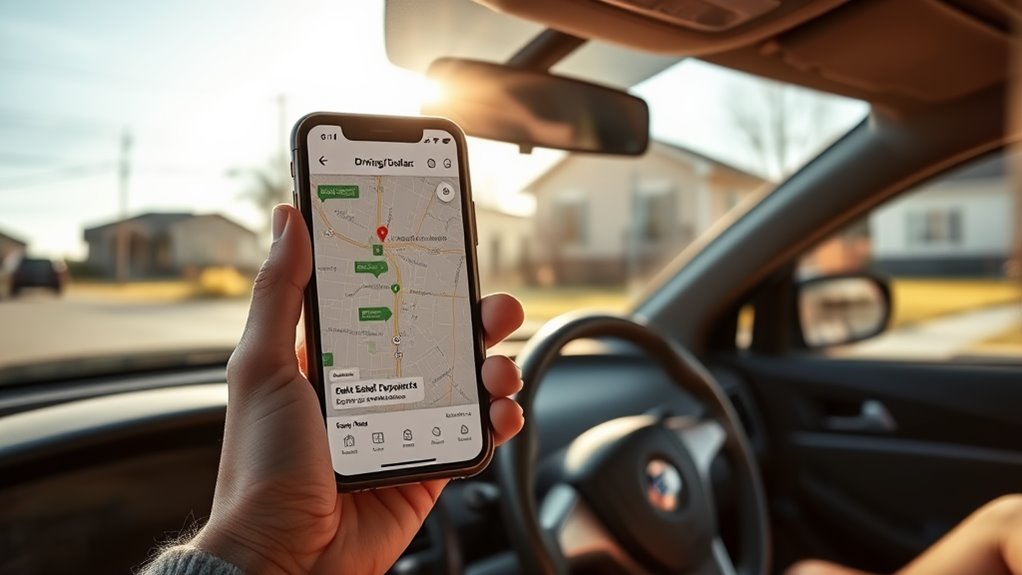Driving for dollars is a hands-on real estate strategy where you physically scout neighborhoods to find distressed or off-market properties. You’ll spot signs like overgrown lawns or boarded-up windows, document addresses, and build a targeted lead list. This low-cost approach cuts competition and connects you with motivated sellers. Tools like mapping apps streamline the process, helping you focus on high-potential deals. Stick with it, and you’ll uncover hidden opportunities that boost your investment portfolio and understand what is driving for dollars.
Key Takeaways
- Driving for Dollars is a real estate strategy where investors physically search for distressed or vacant off-market properties to identify potential deals.
- It involves visually inspecting neighborhoods for signs of neglect, such as overgrown yards, broken windows, or boarded-up doors.
- Investors document property details, including addresses and photos, to create a personalized list of motivated sellers for follow-up.
- This low-cost method reduces lead acquisition expenses compared to traditional marketing, offering direct access to off-market opportunities.
- Tools like Google Street View and apps like DealMachine enhance efficiency in identifying and tracking potential investment properties.
What Is Driving for Dollars
When you’re aiming to uncover hidden real estate opportunities, Driving for Dollars (D4D) is a hands-on strategy that lets you target off-market properties many investors overlook. You physically or virtually drive through neighborhoods to spot distressed or vacant homes—overgrown lawns, boarded-up windows, or peeling paint signal potential deals. By documenting addresses and snapping photos, you create a tailored list of leads. Tools like Google Street View can aid your initial scouting, but using the best driving for dollars app, like DealMachine, streamlines logging and managing property data. Keep in mind that driving for dollar efforts often require persistence—you might evaluate 50 properties before finding one viable deal. Engage with owners or neighbors directly to uncover motivation to sell and refine your approach. This method gives you access to opportunities others miss, turning overlooked properties into profitable investments through consistent, strategic effort. Compile a list of 500-1,000 distressed properties to maximize outreach and increase your chances of finding profitable deals.
Benefits of Driving for Dollars for Investors
Driving for Dollars gives investors direct access to off-market properties, creating opportunities that competitors often miss. By using a driving for dollars app, you can efficiently identify distressed homes, reducing lead acquisition costs compared to traditional marketing channels. This technique allows you to build a personalized list of motivated sellers, increasing your chances of closing deals at favorable terms. It’s a low-cost, high-reward strategy, enabling you to allocate more resources toward property acquisition and renovation. Drive for dollars is scalable, letting you expand your territory as you grow, uncovering more leads and maximizing your investment potential. Driving for dollars real estate focuses on lower-priced, neglected properties, often owned by sellers keen to negotiate. This strategic approach keeps you ahead in competitive markets, giving you a steady pipeline of deals others overlook. Utilizing high-quality photos in your listings can significantly enhance the visual appeal of identified properties, attracting potential buyers or tenants more effectively. It’s a pragmatic way to build your portfolio while maintaining strong profit margins.
Identifying Distressed Properties on the Road

Several visual cues can give you a quick advantage in spotting distressed properties while on the road. Look for properties that show signs of neglect or vacancy, as these are prime candidates for investment opportunities. Focus on neighborhoods with higher concentrations of distressed homes to maximize your efficiency. To identify potential deals, keep an eye out for:
- Overgrown yards or unkempt landscaping
- Broken windows or boarded-up doors
- Overflowing mail or piles of newspapers
- Visible signs of disrepair or neglect
These indicators often point to homeowner frustration or abandonment, making them low-hanging fruit for investors. Document each property by recording the address and taking clear photographs for future research. Stay strategic by concentrating your efforts on areas with multiple distressed properties, as this increases your chances of finding a viable deal. Prioritize speed and precision to outpace competitors. Understanding tenant demographics can further refine your strategy for identifying properties with the highest potential for rental demand.
Essential Tools and Techniques for Effective Drives
Plan your driving routes strategically using GPS to avoid repetitive coverage and maximize exposure to high-potential areas. Document property details efficiently with a smartphone or app, ensuring accurate data collection for future follow-ups. Customize your approach by setting clear goals, like identifying a set number of properties per drive, to stay focused and productive.
Route Planning Essentials
Once you’ve identified target neighborhoods with potential deals, focus on creating a streamlined route that maximizes efficiency and minimizes wasted time. Utilize mapping tools to define specific areas and guarantee thorough coverage without redundancy. Conduct preliminary research on neighborhoods to identify market characteristics and property types, enhancing your driving strategy. Limit daily drives to manageable lists of 30 properties or fewer to maintain focus and productivity. Enhance your research by leveraging professional-grade tools available for real estate investment.
- Use Geofencing: Pinpoint high-concentration areas to maximize property discovery.
- Employ Polygon Tools: Define exact boundaries for targeted driving routes.
- Leverage Tracking Apps: Avoid duplicating efforts by recording past routes.
- Stay Organized: Prepare tools like a camera, notepad, and GPS for efficient documentation.
This strategic approach guarantees you capitalize on every opportunity while conserving time and resources.
Data Collection Strategies
With your route optimized and high-concentration areas mapped out, shifting focus to data collection guarantees you gather actionable insights from each property visited. Leverage tools like DealMachine to automatically log locations, confirming accuracy and efficiency throughout your drive. Utilize tenant screening solutions to assess the viability of potential rentals encountered during your drive. Limit daily tours to 30 properties or fewer for detailed observations, capturing signs of distress like overgrown lawns or boarded windows in photos for future reference. Don’t hesitate to engage neighbors or property owners; their insights can uncover valuable details about owners and conditions. After identifying potential leads, supplement your findings by researching public records for ownership and contact details. This systematic approach confirms you’re not just driving but strategically collecting data that maximizes your opportunities for successful deals.
Building and Managing Your Property Lead List

Every successful Driving for Dollars strategy hinges on a well-built property lead list. Start by documenting distressed or vacant properties you spot, taking photos and notes for future reference. Use tools like DealMachine to streamline the process, aiming for at least 50 addresses per hour. Segment your leads based on property conditions and owner demographics to tailor your outreach and boost your chances of connecting with motivated sellers. Here’s how to manage your list effectively:
- Organize leads into qualified and unqualified categories to prioritize follow-ups.
- Track your routes using GPS-enabled apps to maximize efficiency and coverage.
- Segment strategically by condition, location, and owner details for targeted outreach.
- Maintain consistency in follow-ups through texts, calls, and direct mail to convert leads into deals.
A well-managed lead list keeps you focused and opportunistic, turning driving efforts into actionable opportunities. Consider integrating high-equity owner data to identify properties with significant potential for profitable deals.
Post-Drive Actions to Maximize Investment Opportunities
After qualifying your leads, research identified properties to uncover potential investment value and tailor your approach. Use your findings to prioritize efforts and secure deals that align with your investment goals, especially when leveraging seller financing. Engage with property owners directly through targeted campaigns or personal outreach to build rapport and assess their motivation.
Research Identified Properties
Once you’ve identified potential properties during your drive, categorize them into qualified and unqualified lists to prioritize your follow-up efforts. Research each property thoroughly to uncover details like ownership history, tax status, and market value, as these insights will shape your negotiation strategy. Leverage public records and tools like DealMachine to streamline data collection and guarantee accuracy. Document your observations with photos and notes to create a thorough property profile. Use this organized approach to maximize your opportunities. Consider exploring seller financing as a flexible option to structure deals and attract motivated sellers.
- Sort properties into qualified and unqualified lists for focused action.
- Research ownership and property details to identify seller motivations.
- Document observations with photos and notes for future reference.
- Utilize tools like DealMachine to automate and track your leads efficiently.
Engage With Property Owners
When you’ve categorized your identified properties, engaging with owners becomes the critical next step to transforming leads into deals. Use your tracking software’s Set Status function to outline follow-up actions, ensuring you’re organized and focused. Reach out directly with personalized messages, referencing specific details from your drive to build rapport and interest. For high-motivation leads, consider door knocking to establish face-to-face communication and gauge seller intent. Implement a multi-touch campaign, combining text messages, calls, and postcards to maintain consistent contact. This layered approach increases your chances of converting leads into deals while demonstrating professionalism and persistence. Prioritize efficiency by targeting qualified properties first, and don’t hesitate to adapt your strategy based on responses. By staying proactive, you’ll maximize opportunities to secure lucrative investments.
Conclusion
You’re the treasure seeker traversing uncharted streets in a maze of forgotten homes. Every turn could reveal your next golden opportunity. Equip yourself with the right tools, map your route, and let intuition guide you. Remember, beneath the worn facades lie hidden gems—your next investment. Drive with purpose, seize potential, and transform overlooked properties into lucrative ventures. The hunt’s on!




